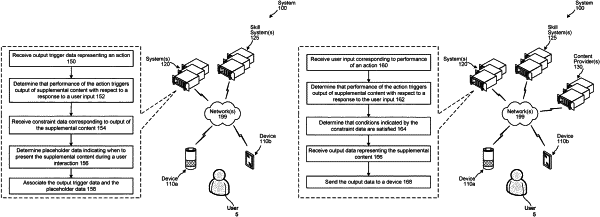| CPC G06F 16/90332 (2019.01) [G06F 16/9035 (2019.01); G10L 15/22 (2013.01); G10L 2015/228 (2013.01)] | 19 Claims |

|
1. A computer-implemented method comprising:
during a first time period:
receiving trigger data representing an action to be performed using a skill system;
determining that performance of the action triggers output of first content that is unresponsive to a first user input;
receiving, from the skill system, constraint data corresponding to the first content, the constraint data indicating a device type and a time duration;
determining, using the constraint data, content placement data indicating when the first content is to be presented during a user interaction; and
associating the trigger data with the content placement data; and
during a second time period after the first time period:
receiving, from a device, audio data representing an utterance;
determining that an intent associated with the utterance corresponds to performance of the action;
determining first output data corresponding to performance of the action, the first output data responsive to the utterance;
determining, using the trigger data, that the first content is to be presented, the first content being unresponsive to the utterance;
sending the content placement data to the skill system;
receiving, from the skill system, second output data representing the first content;
determining that the device is associated with the device type;
determining that a current time is within the time duration;
sending the first output data to the device; and
sending the second output data to the device for output after the first output data.
|